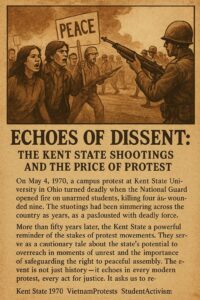On May 4, 1970, a campus protest at Kent State University in Ohio turned deadly when the Ohio National Guard opened fire on unarmed students, killing four and wounding nine. The students had gathered to protest the U.S. invasion of Cambodia, an escalation of the already controversial Vietnam War. Tensions had been simmering across the country for years, as young Americans grew increasingly frustrated with the war, the draft, and the lack of transparency from their government. The Kent State shootings became a flashpoint in this nationwide protest movement, symbolizing the dangerous intersection between civil disobedience and government response.
The tragedy forced a national reckoning. How could peaceful protesters—many of them teenagers—be met with deadly force on a university campus in the heart of America? Public outrage swept across the country, igniting further demonstrations and deepening the generational divide. The government, caught off guard by the scale and passion of the protests, found itself walking a fine line between maintaining order and suppressing dissent. For many, Kent State epitomized the fear that the state might prioritize control over conscience, even at the cost of innocent lives.
More than fifty years later, the Kent State shootings remain a powerful reminder of the stakes involved in protest movements. They serve as a cautionary tale about the state’s potential to overreach in moments of unrest and the importance of safeguarding the right to peaceful assembly. The event is not just history—it echoes in every modern protest, every act of resistance, and every cry for justice. It asks us to remember the cost of silence and the courage it takes to stand up, even when the risk is high.

